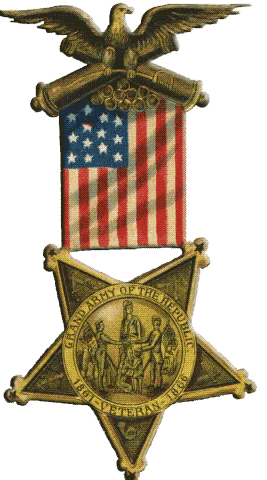Benjamin F. Stephenson, a medical doctor from Springfield, Illinois, had the idea that an association of Union veterans should exist in order to provide for the mututal benefit of its members and for their widows and orphans. Along with a small group of friends, he devised the concept of The Grand Army of the Republic in the spring of 1866. On April 6, 1866, the first post was established in Decatur, Illinois. By July 12, 1866, when a state convention was held to form the Department of Illinois, 39 posts had been chartered. The G.A.R. soon spread throughout the country and developed into a highly effective lobbying organization with strong ties to the Republican Party. At the first national encampment, which took place at Indianapolis on November 20 of that year, ten states and D.C. will represented.
The first commander in chief was General S.A. Hurlburt of Illinois. He was succeeded by General John A. Logan, also of Illinois, who served three terms before being succeeded by Genral A.E. Burnside.
At its peak around 1890, the G.A.R. enjoyed a membership of 400,000. It was instrumental in establishing the Memorial Day holiday in 1868. Its most important contribution was as a pressure group designed to secure pensions for Union veterans. The G.A.R. also was successful in persuading Congress to approve veterans' preference in federal job openings.
 The G.A.R. was instrumental in denying a second term to Grover Cleveland in the Election of 1888. The president, unlike his Republican predecessors, had carefully screened the numerous individual pension bills passed by Congress; those thought to be fraudulent were vetoed. Cleveland also blocked a major Dependent Pension bill in 1887, angering many former soldiers and impairing his reelection chances.
The G.A.R.'s lobbying of politicians was deemed by many to be heavy-handed, as was the organization's censorship of school textbooks as a means to obtain an acceptable version of American history.
The influence of the G.A.R. declined rapidly after 1900. The last member of the Grand Army of the Republic died in 1956. Its Confederate counterpart was the United Confederate Veterans.
The G.A.R. was instrumental in denying a second term to Grover Cleveland in the Election of 1888. The president, unlike his Republican predecessors, had carefully screened the numerous individual pension bills passed by Congress; those thought to be fraudulent were vetoed. Cleveland also blocked a major Dependent Pension bill in 1887, angering many former soldiers and impairing his reelection chances.
The G.A.R.'s lobbying of politicians was deemed by many to be heavy-handed, as was the organization's censorship of school textbooks as a means to obtain an acceptable version of American history.
The influence of the G.A.R. declined rapidly after 1900. The last member of the Grand Army of the Republic died in 1956. Its Confederate counterpart was the United Confederate Veterans.